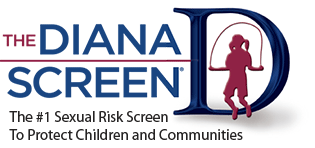Q: What is The Diana Screen ?
A: The Diana Screen is an easy to use, computer-based, pre-hire/volunteer risk management screen that reduces sexual risk to children and teens. Scientifically validated and backed by over 20 years of research, The Diana Screen asks a series of questions that helps to identify applicants who fail to recognize sexual boundaries between adults and children.
The Diana Screen
-
Helps identify the safest staff and volunteers to care for
children and teens
-
Helps identify applicants who fail to recognize sexual
boundaries between adults and children and those at a high
risk to have already sexually abused a child
-
Is easy to use and fast
-
Is administered on a computer
-
Is on a 4th grade reading level
-
Is available in English and Spanish
-
Results available the same day
-
Is scientifically validated
®
®
®
®

Q: What are adult-child sexual boundaries?
A: Adults serving as volunteers or staff in youth-serving organizations and programs have a responsibility to maintain healthy sexual and professional boundaries with the children and teens with whom they volunteer or work. There is usually an imbalance of power and status in these relationships as the youth depend on these adults for their skills, knowledge, guidance, and advice. Youth-serving adult volunteers and staff have a responsibility not to exploit this trust and dependency for personal gain. Sexual boundary violations include the crossing of emotional, communication, and physical boundaries of youth:
-
Emotional boundary violations can include giving and receiving gifts of a personal nature, becoming over-involved in a child or teen’s life, sharing secrets, spending a lot of alone time together, or allowing the child or teen to do things against the parents’ wishes. Emotional boundaries are crossed when the adult volunteer or staff member treats the relationship with the child or teen as if it were a romantic or close adult relationship.
-
Communication boundary violations include sexually-oriented conversations such as commenting on a child or teen’s physique, appearance, or developing body; teaching or talking about sex or sexual experiences; or making any sexually-related remarks.
-
Physical boundary violations occur when youth-serving volunteers or staff do not respect a child or teen’s privacy and personal space or fail to set appropriate limits of physical contact.
Q: What is child sexual abuse?
A: All sexual touching between an adult and a child is sexual abuse. Sexual touching between children can also be sexual abuse when there is a significant age difference (often defined as 3 or more years) between the children or if the children are very different developmentally or size-wise. Sexual abuse does not have to involve penetration, force, pain, or even touching. Sometimes it is perpetrated by trick or manipulation. If an adult engages in any sexual behavior (looking, showing, or touching) with a child to meet the adult’s sexual needs or interest, it is sexual abuse.
Q: What types of agencies should use The Diana Screen ?
A: All types of agencies, programs, and corporations that serve children and teens should use The Diana Screen . This includes schools, child-care programs, children’s hospitals, residential treatment centers, mentoring programs, juvenile detention facilities, faith-based organizations, foster care programs, scouting organizations, camps, and youth sports leagues, among other categories of youth-serving organizations.
®
®
Q: What can I expect from The Diana Screen that I cannot expect from a criminal background check?
A: Because most acts of child and teen sexual abuse are never reported to the police, criminal background checks are largely ineffective at identifying individuals who may have already sexually abused a child. In fact, ChoicePoint reported looking at over 3.5 million background checks and finding only 0.2% that could be identified as sexual offenders. In contrast to background checks, The Diana Screen does not rely on public records or criminal histories. The Diana Screen methodology provides much more effective results.
Using The Diana Screen accomplishes the following:
-
Helps identify adults who are most likely to cross sexual boundaries with children and teens
-
Acts as a deterrent
-
Helps agencies select the safest adults to work with children and teens by forming a safer pool of prospective hires and volunteers
Q: Should The Diana Screen be used as a stand-alone tool?
A: No, The Diana Screen should be used as one component of an organization’s overall application/interview/screening process and is one piece of information to gather and include in an agency’s decision-making process. One of the many benefits of The Diana Screen is that it is able to quickly and inexpensively ask the sexual risk questions that most staff do not have the experience to ask. While The Diana Screen greatly reduces risk, it does not eliminate it. Agencies must still provide quality training, good supervision, and implement effective practices and policies that allow staff and volunteers to make healthy connections with children and teens while maintaining appropriate professional boundaries.
